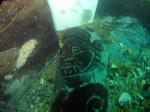 The Swash Channel Wreck, so named after the location of its discovery off the coast of Dorset, England, dates to the early 17th century and was discovered in 2004 during an archaeological survey commissioned in anticipation of a harbor dredging. That same year it was declared a protected wreck site, and a diving team in 2005 photographed large portions of timber work, including the frames, ceiling, outer planting and a large segment of deck that is thought to be 130 feet long.
The Swash Channel Wreck, so named after the location of its discovery off the coast of Dorset, England, dates to the early 17th century and was discovered in 2004 during an archaeological survey commissioned in anticipation of a harbor dredging. That same year it was declared a protected wreck site, and a diving team in 2005 photographed large portions of timber work, including the frames, ceiling, outer planting and a large segment of deck that is thought to be 130 feet long.
 During ongoing exploration by maritime archaeologists from Bournemouth University, a 27.5-foot section of bow or quarterdeck decorated with an elaborately carved merman was recovered from the wreck. The dendrochronogical analysis found that the timbers were felled around 1585. [Correction: two years later, the tree-ring date has been revised to Spring of 1628.] That makes these pieces the earliest carved ship timber still in existence in Britain. A large number of artifacts was also found on the wreck site. Weaponry, barrels, ceramic vessels, leather shoes, barrels, drinking cups, all testify that this ship was extremely well-appointed. The richness of the ship and its artifacts plus its early date make this wreck the most important one found in British waters since the Mary Rose.
During ongoing exploration by maritime archaeologists from Bournemouth University, a 27.5-foot section of bow or quarterdeck decorated with an elaborately carved merman was recovered from the wreck. The dendrochronogical analysis found that the timbers were felled around 1585. [Correction: two years later, the tree-ring date has been revised to Spring of 1628.] That makes these pieces the earliest carved ship timber still in existence in Britain. A large number of artifacts was also found on the wreck site. Weaponry, barrels, ceramic vessels, leather shoes, barrels, drinking cups, all testify that this ship was extremely well-appointed. The richness of the ship and its artifacts plus its early date make this wreck the most important one found in British waters since the Mary Rose.
 Unfortunately, it’s in grave danger from shifting currents and being in the middle of a busy shipping lane. More and more wood is being exposed as the sand moves, and the exposed wood is a tasty meal for bacteria and shipworms.
Unfortunately, it’s in grave danger from shifting currents and being in the middle of a busy shipping lane. More and more wood is being exposed as the sand moves, and the exposed wood is a tasty meal for bacteria and shipworms.
They can’t just rebury the ship, which would be the safest and most immediate solution to keep the wood from deteriorating further, because it would create a bump on the seafloor that would interfere with traffic in the shipping lane. They can’t lift the whole thing because so much of it is still buried; it would be prohibitively expensive and take a long time, more time than the timbers may have. The Bornemouth University team has therefore decided to raise and preserve the largest section of the exposed wood next month, then rebury the flatter pieces that remain.
David Payton, senior lecturer in marine archaeology at [Bournemouth University], said: “The damage there has increased dramatically since we first started studying it. It’s a race – you’ve only got a certain amount of time before it’s too late and there’s no point.
“It’s been buried until now, but in the last four or five years it’s become exposed. The longer the wreck is exposed, the more damaged it will be. If nothing were done within the next five years there’d be nothing left.”
The easiest and most effective way to preserve the ship would be to rebury it, but this is not an option for the whole vessel, as it would create a hump on the seabed in a crucial shipping channel. Instead, scientists plan to pull out those sections of the ship that would be in the way and rebury the rest.
The main piece to be raised will be six metres of the hull from the bow backwards. These timbers, once recovered, will go on display in Poole Museum.
Research continues, meanwhile, to determine the origin and name of the ship. The timbers came from the German-Dutch border, but even with the original point of the wood and its date of felling, so far no records have been found that identify the wreck.
There’s underwater footage of the wreck in this BBC video, and the ship’s preservation will be the subject of an upcoming episode of the BBC show Britain’s Secret Seas.
Not an ideal solution, but seems the only viable option. The carving looks incredible!